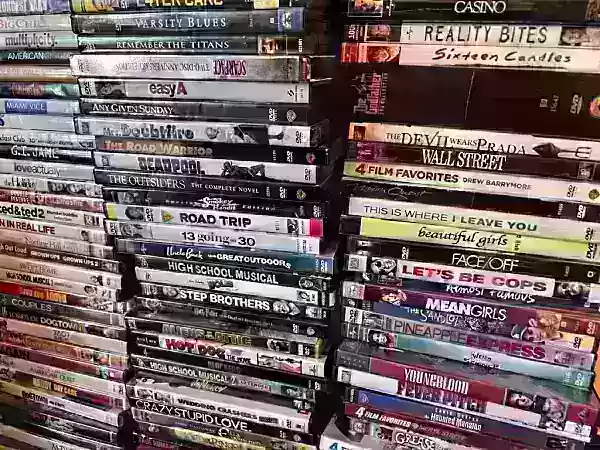If, like many of us, you’ve got a collection of DVDs proudly displayed on your shelf, recent reports might have sparked some concern about whether any of those discs have fallen victim to disc rot. This isn’t just a niche worry—it’s a real issue that has affected physical media for decades, impacting everything from LaserDiscs and CDs to modern game discs and DVDs. Due to chemical deterioration over time, these discs can develop playability issues, sometimes to the point where they become completely unreadable.
While encountering disc rot is often a matter of bad luck or poor storage conditions, there are known cases where the problem stems directly from how certain discs were manufactured. One such case involves a notable run of Warner Bros. DVDs produced between 2006 and 2009. This issue gained renewed attention thanks to a report by JoBlo’s Chris Bumbray, who discovered the problem firsthand with classic box sets like those featuring Humphrey Bogart and Errol Flynn. However, this wasn't news to many collectors—YouTuber Spencer Draper (also known as Damn Fool Idealistic Crusader) had already explored the topic in depth in a video released in late 2021, confirming what many suspected about the origins of the problem.
The Root Cause: A Manufacturing Flaw
Through careful research, Draper and others traced the issue back to one specific manufacturing facility: the now-closed Cinram plant in Pennsylvania. The key clue was found in tiny manufacturing codes etched onto the inner ring of the discs. These markings helped identify which plant produced them. Although not every WB DVD from this era is defective, those made at the Cinram plant seem to be particularly prone to early degradation.
Spencer Draper, a dedicated collector with an estimated 5,000–6,000 films across various formats, described his panic upon learning about this issue. He went through his entire collection, disc by disc, to check for signs of damage. As he explained, even digital backups aren’t foolproof since problems may only appear during certain parts of the disc—like bonus features or menu navigation.
Warner Bros.’ Response to the Issue
Draper reached out to Warner Bros. Home Entertainment (WBHE) multiple times and documented the process in his videos. Eventually, WBHE responded by replacing many of the affected titles—though only if they were still in production. IGN contacted WBHE for further comment, and the studio provided a statement:
*“Warner Bros. Home Entertainment is aware of potential issues affecting select DVD titles manufactured between 2006 – 2009 and has been working directly with consumers on replacements or alternate solutions for nearly a decade. Any consumer who is experiencing an issue can contact* *[email protected]**. This is not a new issue. A website recently experienced this issue themselves and decided to write a story about it (since updated), which caused the latest news. WBHE has been working with consumers for nearly a decade when it was first brought to our attention. We have offered replacements when possible, or an alternate title when needed. Some of the discs are now out of print or the titles no longer licensed for DVD release. In these cases, WBHE offered an alternate title as a replacement.”*
This aligns with the response given to JoBlo and confirms the expanded timeframe Draper noticed while reviewing affected titles.
How to Check If Your DVDs Are Affected
If you're concerned about your collection, start by checking the copyright year on the back of the DVD case. If it falls between 2006 and 2009, it could potentially be affected. Next, examine the inner ring of the disc itself. Look for the letters “IFPI” followed by a short code. If you see that, especially without a blue stamp reading “Disc Made in Mexico” on the packaging, there’s a chance the disc came from the problematic Cinram plant.
Because these codes are small and hard to read, you may need a magnifying glass or camera zoom to spot them. Alternatively, simply test the disc by playing through the main feature and all extras. If you notice skipping, glitches, or failure to load certain sections, it may be showing early signs of rot.

Real-World Examples and Collector Impact
Draper maintains a helpful list of known affected titles, which serves as a valuable resource for collectors. Notably, some of these titles are rare or no longer available digitally, making replacement difficult or impossible. For example, HBO's *Tales From the Crypt* was only ever released on DVD by Warner Bros., and many of those sets suffer from playback issues due to disc rot. Similarly, Volume Two of the classic RKO Tarzan films is another affected title with limited availability and high resale prices.
What makes the WB DVD rot issue more unpredictable than older media like LaserDiscs is its inconsistency—some discs may work fine for years before suddenly failing. Unlike LaserDiscs, which tended to degrade predictably after a certain point, WB DVDs from this period can fail unexpectedly, even after multiple successful plays.
What Is the Life Expectancy of a DVD?
Despite these concerns, most DVDs remain durable when stored properly. According to Sony’s official statement, a typical DVD has a life expectancy of anywhere from 30 to 100 years under proper conditions. With DVDs approaching their 30th anniversary since introduction in 1996, most well-maintained discs—including many early Warner Bros. releases—are still performing perfectly.
Blu-rays also seem largely unaffected, though isolated incidents—like a small number of faulty discs traced to a French manufacturer—have occurred. On the other hand, HD DVDs, the failed competitor to Blu-ray, are now entirely unplayable for most users.

Lessons from Criterion and Consumer Advocacy
Criterion once faced a similar issue with a batch of Blu-rays made at a single plant, but unlike Warner Bros., they acknowledged the problem publicly, identified affected titles, and launched an exchange program. Draper wishes Warner Bros. had taken a similarly transparent approach, including publishing their own list of affected discs and clearly explaining the Cinram connection.
Consumers trying to replace discs should email [email protected], though experiences vary widely—from prompt responses to long waits and requests for receipts that most people no longer have. Additionally, some titles are no longer in print or are tied up in rights issues, meaning WB may offer alternate titles instead, which isn’t always satisfactory for collectors.
The Value—and Vulnerability—of Physical Media
Physical media remains one of the few reliable ways to preserve access to films and shows in an age where streaming libraries change constantly. But the Warner Bros. DVD rot issue highlights a major vulnerability—one that continues to affect collectors years after the fact. While the closure of the Cinram plant may have ended the source of the problem, its legacy lives on in countless collections, reminding us that even the most beloved movies can fade away if we’re not vigilant.






